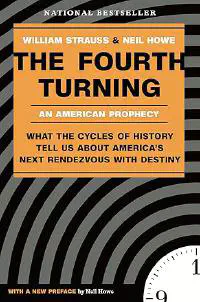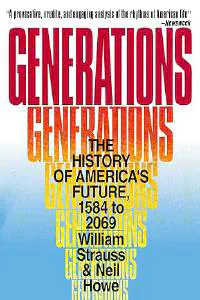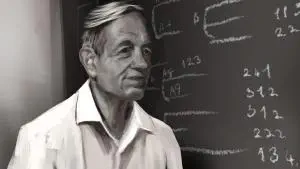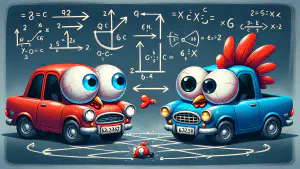Overview
The Strauss–Howe generational theory, developed by American authors William Strauss and Neil Howe, describes a recurring cycle in American history based on generational change. Introduced in Generations (1991) and expanded in The Fourth Turning (1997), the theory argues that American society moves through a repeating pattern roughly every 80 to 100 years, encompassing four generational archetypes and four corresponding eras, or “turnings.”
The four generational archetypes are the Prophet, Nomad, Hero, and Artist. These generations follow one another in a fixed order and are shaped by their unique coming-of-age experiences. For example, Baby Boomers are seen as Prophets born after a Crisis, Generation X as Nomads born during an Awakening, Millennials as Heroes born after an Awakening, and the Silent Generation as Artists born during a Crisis. Each archetype plays a distinct role in the broader societal cycle.
The theory also outlines four turnings, or eras, that recur sequentially, each lasting around two decades. These are: “The High,” marked by institutional strength and civic order (e.g., post-World War II prosperity); “The Awakening,” a time of spiritual and cultural rebellion (e.g., the 1960s–70s counterculture movement); “The Unraveling,” characterized by weakening institutions and rising individualism (e.g., growing distrust in public institutions during the 1980s–2000s); and “The Crisis,” a period of upheaval and transformation (e.g., potentially the 2020s). Each turning corresponds with the emergence of a specific generational archetype.
The Crisis phase, often triggered by major national or global challenges, is seen by Strauss and Howe as both a dangerous and regenerative period during which society rebuilds its institutions and lays the groundwork for a new High. They argue that the United States entered a new Crisis phase in the late 2000s, marked by financial instability, political polarization, and global uncertainty—a period that could culminate in a profound transformation of national values and institutions, ultimately paving the way for renewed unity and civic strength.
Despite its influence in some policy and cultural circles, the Strauss–Howe theory has drawn criticism from scholars. Detractors argue that it oversimplifies complex historical dynamics, depends too heavily on anecdotal patterns, and may suffer from confirmation bias. While the theory provides a compelling narrative structure for viewing U.S. history, its predictive accuracy and rigid generational labels remain contested.
In Context

A turning is a social mood that changes each time the generational archetypes enter a new constellation. Each turning is roughly the length of a phase of life.
The First Turning is a High—an upbeat era of strengthening institutions and weakening individualism, when a new civic order implants and the old values regime decays. (Nomads enter elderhood; Heroes, midlife; Artists, young adulthood; and Prophets, childhood.)
The Second Turning is an Awakening—a passionate era of spiritual upheaval, when the civic order comes under attack from a new values regime. (Heroes enter elderhood; Artists, midlife; Prophets, young adulthood; and Nomads, childhood.)
The Third Turning is an Unraveling—a downcast era of strengthening individualism and weakening institutions, when the old civic order decays and the new values regime implants. (Artists enter elderhood; Prophets, midlife; Nomads, young adulthood; and Heroes, childhood.)
The Fourth Turning is a Crisis—a decisive era of secular upheaval, when the values regime propels the replacement of the old civic order with a new one. (Prophets enter elderhood; Nomads, midlife; Heroes, young adulthood; and Artists, childhood.)
A generation is composed of people whose common location in history lends them a collective persona. The span of one generation is roughly the length of a phase of life. Generations come in four archetypes, always in the same order, whose phase-of-life positions comprise a constellation.
The Prophet archetype is born in a High and enters young adulthood in an Awakening, midlife in an Unraveling, and elderhood in a Crisis.
The Nomad archetype is born in an Awakening and enters young adulthood in I an Unraveling, midlife in a Crisis, and elderhood in a High.
The Hero archetype is born in an Unraveling and enters young adulthood in a Crisis, midlife in a High, and elderhood in an Awakening.
The Artist archetype is born in a Crisis and enters young adulthood in a High, midlife in an Awakening, and elderhood in an Unraveling.
During a Fourth Turning, the constellation contains all four archetypes born in the current saeculum. During the first three turnings, the constellation includes one or more archetypes born in the prior saeculum.
1. A dominant, inner-fixated IDEALIST GENERATION grows up as increasingly indulged youths after a secular crisis; comes of age inspiring a spiritual awakening; fragments into narcissistic rising adults; cultivates principle as moralistic midlifers; and emerges as visionary elders guiding the next secular crisis.
2. A recessive REACTIVE GENERATION grows up as underprotected and criticized youths during a spiritual awakening; matures into risk-taking, alienated rising adults; mellows into pragmatic midlife leaders during a secular crisis; and maintains respect (but less influence) as reclusive elders.
3. A dominant, outer-fixated CIVIC GENERATION grows up as increasingly protected youths after a spiritual awakening; comes of age overcoming a secular crisis; unites into a heroic and achieving cadre of rising adults; sustains that image while building institutions as powerful midlifers; and emerges as busy elders attacked by the next spiritual awakening.
4. A recessive ADAPTIVE GENERATION grows up as overprotected and suffocated youths during a secular crisis; matures into risk-averse, conformist rising adults; produces indecisive midlife arbitrator- leaders during a spiritual awakening; and maintains influence (but less respect) as sensitive elders.
A generation is composed of people whose common location in history lends them a collective persona. The span of one generation is roughly the length of a phase of life. Generations come in four archetypes, always in the same order, whose phase-of-life positions comprise a constellation.
The Prophet archetype is born in a High and enters young adulthood in an Awakening, midlife in an Unraveling, and elderhood in a Crisis.
The Nomad archetype is born in an Awakening and enters young adulthood in I an Unraveling, midlife in a Crisis, and elderhood in a High.
The Hero archetype is born in an Unraveling and enters young adulthood in a Crisis, midlife in a High, and elderhood in an Awakening.
The Artist archetype is born in a Crisis and enters young adulthood in a High, midlife in an Awakening, and elderhood in an Unraveling.
During a Fourth Turning, the constellation contains all four archetypes born in the current saeculum. During the first three turnings, the constellation includes one or more archetypes born in the prior saeculum.






